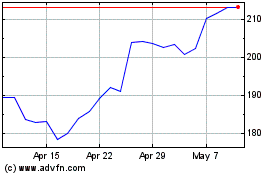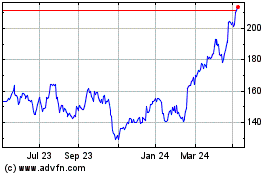Barclays Beats 3Q Market Expectations Despite Impairment Charge --Update
October 23 2020 - 3:33AM
Dow Jones News
--Barclays exceeded market expectations on net profit, pretax
profit and total income for the third quarter
--The U.K. lender booked lower-than-anticipated impairments
--The bank said its outlook depends on the outcome of the
coronavirus pandemic and Brexit negotiations
By Sabela Ojea
Barclays PLC on Friday reported third-quarter total income, net
profit and pretax profit that were higher than the market had
expected despite booking a considerable amount of provisions.
The FTSE-100-listed lender cautioned that its outlook is
dependent on the coronavirus pandemic, as well as on the outcome of
the Brexit negotiations. "Certain headwinds to income in Barclays
U.K. are anticipated to persist in 2021, including the low interest
rate environment," it added.
Regarding its full-year costs, the bank expects them to be flat
compared with the prior year. However, it noted that it will
evaluate a reduction of structural costs, which could result in
additional charges.
U.K. bank posted pretax profit of 1.15 billion pounds ($1.50
billion) compared with GBP246 million for the same period a year
earlier. Pretax profit was expected to rise to GBP507 million,
according to the bank's own compilation of estimates.
Barclays had a credit impairment charge of GBP608 million, lower
compared with forecasts of GBP1 billion, taken from Barclays's
consensus. The lender said that it expects to book a second-half
impairment charge materially below the one booked in the first
half, noting that it is likely that the impairment charges for 2021
will be below those of 2020.
Net profit for the quarter rose to GBP611 million from a loss of
GBP292 million for the third quarter of 2019. Net profit was
expected at GBP201 million, according to the bank's consensus.
Total income, on the other hand, decreased to GBP5.20 billion
from GBP5.54 billion for the year-earlier period. It was
anticipated to decline to GBP4.85 billion, according to the bank's
compilation of forecasts.
The bank ended the period with a common equity Tier 1 ratio--a
key measure of balance-sheet strength--of 14.6%, up from 13.8% as
at Dec. 2019.
Return on tangible equity increased to 5.1% compared with a
negative 2.4% RoTE in the third quarter of 2019. Barclays still
targets a RoTE of more than 10%, it added.
Write to Sabela Ojea at sabela.ojea@wsj.com; @sabelaojeaguix
(END) Dow Jones Newswires
October 23, 2020 03:18 ET (07:18 GMT)
Copyright (c) 2020 Dow Jones & Company, Inc.
Barclays (LSE:BARC)
Historical Stock Chart
From Mar 2024 to Apr 2024

Barclays (LSE:BARC)
Historical Stock Chart
From Apr 2023 to Apr 2024
